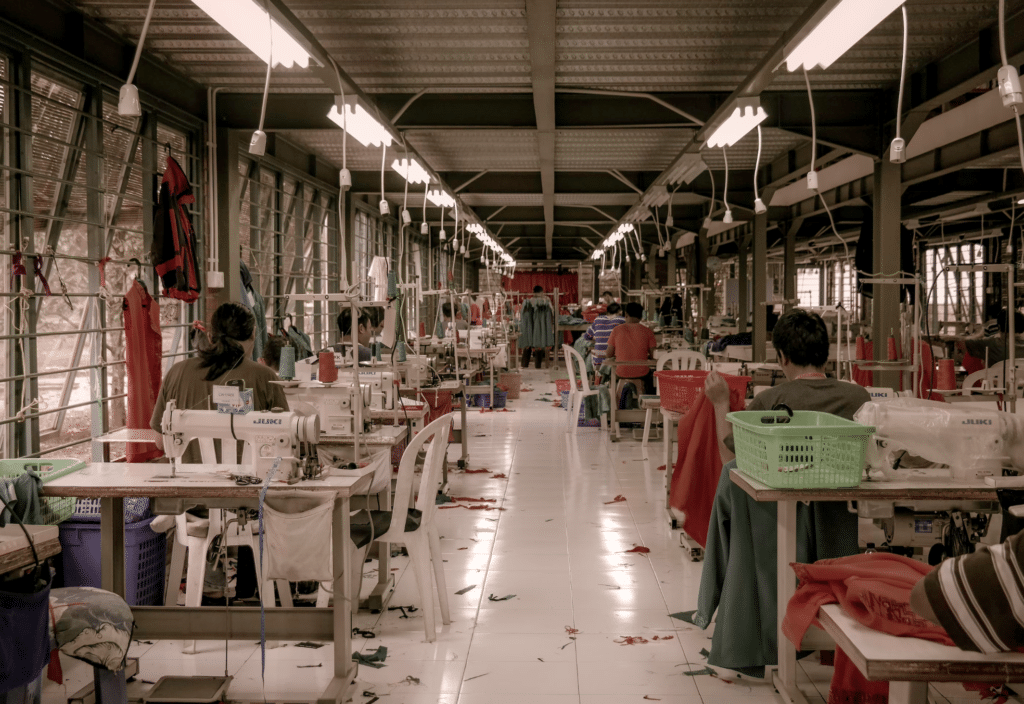Introduction – Carbon Footprint Of Fast Fashion
In this article, we will analyze carbon footprint of fast fashion companies. Fast fashion is a business model characterized by rapidly producing and marketing trendy, affordable clothing in response to the latest fashion trends.
While this model has made fashion more accessible to many consumers, it has raised significant concerns about its environmental impact, particularly in terms of carbon emissions.

At the core of the concerns are high production volumes coupled to short product lifecycles. Fast fashion encourages high production volume which involves energy consumption and carbon emissions during the manufacturing, and short product lifecycles because consumers replace clothing quickly as trends change.
This means that consumers are more likely to discard clothing after a few months or years.
Fashion Contributes 6-8% Of Total Global Carbon Emissions

Strikingly, estimates from The International Labor Organization suggest that the textile and garment sector accounts for a staggering 6-8% of total global carbon emissions.
The problem of fast fashion is particularly alarming due to its potential to contribute even more to emissions. The one silver lining is that fast fashion is still a small part of fashion in general, although it certainly bears the brunt of negative messaging.
In this lies an opportunity as well, because the fast fashion companies that address the emissions problem will be viewed as leaders.
The Top 5 Fast Fashion Companies As Ranked By Revenue
Defining fast fashion is a complex task, as it involves various aspects of the fashion industry, such as production, design, marketing, and consumption patterns.
Sure there is a need for better metrics which is part of our discussion below. We can also use our perceptions to guide us.
There are companies that are not fast fashion because they have long product lifecycles, like Nike or low production volumes, like Hermes. Conversely, here are 5 companies that are commonly perceived as being fast fashion. We rank these by revenue.
| Fast Fashion Company | Revenue 2021 |
| Zara (Inditex) | $29.87 B |
| H&M (Hennes & Mauritz) | $23.36 B |
| Shein | $15.70 B |
| Primark | $6.81 B |
| Boohoo | $2.43 B |
Inditex (Zara): Inditex is one of the world’s largest fashion retailers, with Zara being its flagship brand.
H&M (Hennes & Mauritz AB): This Swedish multinational company is a global fast-fashion leader.
Shein: Chinese fast-fashion e-commerce company that has gained significant popularity in recent years. It offers trendy and affordable clothing, primarily targeting young women. Shein has a strong online presence, operating in multiple countries and regions.
Primark: Owned by Associated British Foods, Primark is a popular fast-fashion retailer in Europe and has appeared in the United States more recently.
Boohoo: UK-based online fast-fashion retailer that has experienced rapid growth since its launch in 2006. The company targets a young demographic with trendy and affordable clothing. Boohoo Group PLC owns several other fashion brands, including PrettyLittleThing, Nasty Gal, and MissPap.
These companies are among the most associated with fast fashion. Without a consistent definition and without data, it’s hard to make definitive statements and easy to proclaim companies as being fast or slow fashion. For example, many people wonder about discount retailers TJ Maxx and Marshall’s if these are fast fashion. But according to our analysis both of them are not.
Simple Method Of Calculating Fast Fashion Emissions
We estimate the carbon emissions of these 5 companies. A very naive, simple method for estimating a company’s carbon emissions involves using its revenue and the carbon emissions per unit of GDP.
This method assumes that the carbon emissions of a company are proportional to its revenue and the overall carbon intensity of the economy. It doesn’t take into account any mitigation to the credit of the company. Here’s a basic formula for the calculation:
Carbon emissions of a company = (Company revenue in dollars) * Total carbon emissions (country) / GDP in dollars
- Company revenue: This is the total revenue generated by the company in a given period, usually measured in dollars.
- GDP: This represents the Gross Domestic Product of the country where the company carries out its operations. GDP is a measure of the total value of goods and services produced within a country in a given period, also usually measured in dollars.
- Total carbon emissions (country): This is the total amount of carbon emissions generated within a country in a given period, typically measured in metric tons of CO2 equivalent.
It’s important to note that this method provides a rough estimate and may not accurately reflect the actual carbon emissions of a company.
It assumes that the company’s carbon emissions are directly proportional to its revenue, which might not be true, especially for companies with varying levels of commitment to sustainable practices.
Most of clothing manufacturing takes place in Southeast Asia and China. We use the global estimates of carbon emissions per dollar of GDP drawn from IEA, the International Energy Agency.
For the low estimate, we used the world averaged carbon emissions per $1000 of GDP which is 0.26 tons CO2 per $1000. For the high estimate, we used the emissions figures of China where much of textile production and processing takes place, which is 0.45 tons CO2 per $1000.
| Fast Fashion Company | Carbon emissions (low estimate) | Carbon emissions (high estimate) | Carbon emissions (mean estimate) |
| Zara (Inditex) | 7.77 million tons CO2 | 13.44 million tons CO2 | 10.60 million tons CO2 |
| H&M (Hennes & Mauritz) | 6.07 million tons CO2 | 10.51 million tons CO2 | 8.29 million tons CO2 |
| Shein | 4.08 million tons CO2 | 7.07 million tons CO2 | 5.57 million tons CO2 |
| Primark | 1.77 million tons CO2 | 3.06 million tons CO2 | 2.42 million tons CO2 |
| Boohoo | 0.63 million tons CO2 | 1.09 million tons CO2 | 0.86 million tons CO2 |
More Sophisticated Estimates Of Carbon Emissions
To obtain more accurate results and account for the specific characteristics of a company and its industry, a more detailed analysis, such as a life cycle assessment (LCA) or a sector-specific emissions factor, should be considered.
To create a metric for the carbon footprint of an item of clothing, we can consider the carbon emissions associated with production, transport, and waste, and then divide it by the “utility years” (the number of years the item is used).
This will provide an estimate of the carbon footprint per year of usage. Here’s a basic formula for the calculation:
Carbon Footprint per Year of Usage = (Emissions of Production + Emissions of Transport + Emissions of Waste) / Utility Years
- Emissions of Production: This represents the carbon emissions generated during the production of the clothing item, including raw material extraction, fabric production, and garment manufacturing. This can vary greatly depending on factors such as the type of material, production processes, and energy sources used in manufacturing.
- Emissions of Transport: This includes the carbon emissions generated during the transportation of the clothing item from the production facility to retail stores or distribution centers, and eventually to the customer. This can depend on factors like the distance traveled and the mode of transportation.
- Emissions of Waste: This accounts for the carbon emissions associated with the disposal of the clothing item after it is no longer usable. This can include emissions from waste management processes such as landfilling, incineration, or recycling.
- Utility Years: This is the number of years the clothing item is expected to be used before it is discarded or replaced. This can vary depending on factors like the quality, durability, and style of the clothing item.
It’s important to note that this formula provides a simplified metric for estimating the carbon footprint per year of usage for an item of clothing. To obtain more accurate results, a life cycle assessment (LCA) should be conducted, considering all the stages of a clothing item’s life cycle and their respective emissions.
Unfortunately, detailed figures for each of these components requires standardization of measurement and then compliance by each company to generate.
Moreover, finding out the “utility years” of each item of clothing would require a tremendous amount of constant surveying. Unless data collection becomes much better, we’re not optimistic this method would work.
Hybrid Method
Creating a hybrid metric that combines the carbon emissions from GDP and an estimate of the utility years of a clothing item can provide a better yet still rough approximation of the carbon footprint of fast fashion companies. Here’s a suggested approach for the hybrid metric:
- Estimate Carbon Emissions from GDP: Use the simpler method of calculating a company’s carbon emissions based on its revenue and the carbon emissions per unit of GDP, as discussed earlier.
- Estimate Utility Years: Estimate the average utility years (the number of years an item is expected to be used) for the clothing items produced by the company.
- Calculate Carbon Emissions per Utility Year: Divide the estimated carbon emissions from GDP by the total utility years of the clothing items produced by the company.
Carbon Emissions per Utility Year (Company) = Carbon Emissions (Company) / Total Utility Years
This hybrid metric provides a rough approximation of the carbon footprint of a fast fashion company based on its revenue and the utility years of its products.
Estimating Utility Years Of Clothing Is Still Difficult
To estimate the utility years of a piece of clothing by surveying customers, a company should develop a survey that gathers information about customers’ clothing usage patterns, querying them on what items or categories of clothing they use, and how long they use their clothing items before discarding them.
In general, we would expect that fast fashion companies have shorter utility years for their clothing items compared to non-fast fashion companies.
For lack of data, let’s assume that fast fashion clothing items last 1 year, whereas the rest of the fashion industry you might expect clothing items to last 3-4 years.
This would entail an adjustment of the carbon emissions of fast-fashion by a factor of 1, whereas other companies would receive an adjustment of 1/3 to 1/4.
| Fast Fashion Company | Carbon emissions (mean estimate) | Carbon emissions of equivalent non-fast fashion company |
| Zara (Inditex) | 10.60 million tons CO2 | 2.65 million tons CO2 |
| H&M (Hennes & Mauritz) | 8.29 million tons CO2 | 2.07 million tons CO2 |
| Shein | 5.57 million tons CO2 | 1.39 million tons CO2 |
| Primark | 2.42 million tons CO2 | 0.60 million tons CO2 |
| Boohoo | 0.86 million tons CO2 | 0.22 million tons CO2 |
What we imply here is that if the fast fashion company instead switched to a different business model but with equivalent revenue of selling “slow fashion“, they would effectively lower their carbon emissions by a factor of 4, mainly through adjusting the “utility years” of each item of clothing.
These figures are only meaningful when comparing fast fashion to slow fashion. We will not do that explicitly until a later article. Instead what we’ll do is compare the fast fashion estimates here to numbers the companies or third parties report elsewhere and discuss the results.
Comparing Our Estimates To Reported Figures
We compiled reported figures from each company where we could so as to be able to compare to our own estimates. Since there’s no concept of “utility years”, we can only compare the raw numbers for comparison. We give sources for each estimate.
| Fast Fashion Company | Carbon emissions (mean estimate) | Reported (self or 3rd party) | Source | Notes |
| Zara (Inditex) | 10.60 million tons CO2 | None | ||
| H&M (Hennes & Mauritz) | 8.29 million tons CO2 | 0.06 million tons | HMG 2019 report | 100 times lower than expected; includes supplier GHGs? |
| Shein | 5.57 million tons CO2 | 6.3 million tons | Time magazine report | Perhaps most accurate |
| Primark | 2.42 million tons CO2 | 6 million tons | Primark corporate report | 2 times than expected |
| Boohoo | 0.86 million tons CO2 | None |
After carrying out this exercise, we discovered interesting patterns. First, there were companies that published no figures.
For example we urge Zara and Boohoo to carry out a carbon accounting assessment and report their carbon emissions numbers using a life cycle accounting approach. Second, the reported figures for companies varied widely compared to expectation as follows.
For H&M, we found reported figures that are 100 times lower than expected. Either this is very good or its very bad.
It could be very good because H&M would be an exemplar in its practices. On the other hand it could be very bad because it’s a type of reporting that obscures whats happening.
In order to understand this, we looked at their report from 2019. We found that the qualifier to the emissions numbers are that they’re from “direct operations”, which we are unable to interpret.
Does this indicate an omission of their suppliers’ emissions, located in China, Turkey and Bangladesh, which are massive emitters because of dirty grids?
In fact, the report says H&M is 95% renewable energy reliant in recent years, which makes sense for their home base in Sweden but less sense in for the suppliers unless the suppliers took extra pains to secure energy from renewable sources.
China, Turkey, and Bangladesh are not known for having low carbon emission energy sources but it’s certainly possible. We encourage H&M to tell us about these details.
For Shein, the reported numbers from the Time magazine article are very close to our estimates, which means they’re starting from a very reasonable baseline and are poised for credible reductions.
For Primark, the reported emissions from their corporate website was unsually high, about 2 to 3 times what we expect. It would be extremely instructive to understand why. Again, greater transparency and standardization of measurement in the industry would go a long way to solving these discrepancies!
For all of these companies, we also urge them to reveal their efforts in reducing carbon in other ways, for example purchase of carbon credits or investments in green technologies elsewhere that doesn’t impact their operations.
Other Efforts
The Ellen MacArthur Foundation is a leading organization focused on accelerating the transition to a circular economy. The Foundation works with businesses, governments, and other stakeholders to develop and promote circular economy practices, aiming to create a more sustainable and regenerative global economy.

In the context of the fashion industry, the Ellen MacArthur Foundation has been actively involved in several initiatives and efforts to address the environmental impact of fast fashion and promote circularity in the sector.
Recently the industry has seen increased efforts to fix its own waste problems. Zara’s parent company, Inditex, which is investing in textile recycling and reuse initiatives like Moda Re, a Spanish charity that plans to double its annual sorting volume to 40,000 metric tonnes.
Still, less than a quarter of Europe’s 5.2 million tonnes of clothing waste is recycled, with the rest ending up in landfills.
The EU is introducing new laws requiring member states to separate textiles from other waste by 2025 and aims to have all textile products sold in the bloc made of recycled fibers by 2030.
Significant investment and technological advancements are needed to meet these goals. And the main issue from the consumer side is overconsumption, and more needs to be done to increase the use of recycled textiles.
Why stop there? Take personal action to combat carbon emissions from fashion. Next winter, assemble a compact minimalist winter ward robe that will cut down on carbon, cut down on your cost, and decrease the amount of mental energy you devote to fashion.
Conclusion – Carbon Footprint Of Fast Fashion
In conclusion, the fast fashion industry has been widely criticized for its environmental impact, particularly in terms of carbon emissions.
Developing metrics to estimate the carbon footprint of fashion companies, not only fast fashion, is essential for understanding and addressing environmental consequences.
While simple methods like using GDP-based carbon emissions can provide a rough approximation, combining this with an estimate of the utility years of clothing items can yield a more accurate and informative metric.
Surveying customers can be an effective way to gather data on the utility years of clothing items, shedding light on the differences between fast fashion and non-fast fashion companies.
Addressing the challenges posed by fast fashion requires a collective effort from companies, consumers, and policymakers to adopt more sustainable practices and promote responsible consumption. What can each of us do?
Awareness of sustainable clothing brands to inform on our consumer behavior is one start.

Anne Lauer
Anna Lauer is a writer, gardener, and homesteader living in rural Wisconsin. She has written for Mother Earth News, Grit, and Hobby Farms magazines. Anna is writing a new book about growing your food for free and an ultimate guide to producing food at little to no cost. When she’s not writing or gardening, Anna enjoys spending time with her husband and two young daughters.
